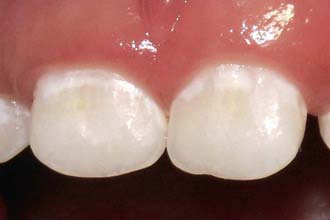Chapter 304 Dental Caries
Etiology
The development of dental caries depends on interrelationships among the tooth surface, dietary carbohydrates, and specific oral bacteria. Organic acids produced by bacterial fermentation of dietary carbohydrates reduce the pH of dental plaque adjacent to the tooth to a point where demineralization occurs. The initial demineralization appears as an opaque white spot lesion on the enamel, and with progressive loss of tooth mineral, cavitation of the tooth occurs (Fig. 304-1).

Figure 304-1 Initial carious lesions (white spot lesions) around the necks of the maxillary central incisors.
Clinical Manifestations
Dental caries of the primary dentition usually begins in the pits and fissures. Small lesions may be difficult to diagnose by visual inspection, but larger lesions are evident as darkened or cavitated lesions on the tooth surfaces (Fig. 304-2). Rampant dental caries in infants and toddlers, referred to as early childhood caries (ECC), is the result of a child colonized early with cariogenic bacteria and the frequent ingestion of sugar, either in the bottle or in solid foods. The carious process in this situation is initiated earlier and consequently can affect the maxillary incisors first and then progress to the molars as they erupt.

Figure 304-2 Rampant caries in a 3 yr old child. Note darkened and cavitated lesions on the fissure surfaces of mandibular molars.
Stay updated, free articles. Join our Telegram channel

Full access? Get Clinical Tree


